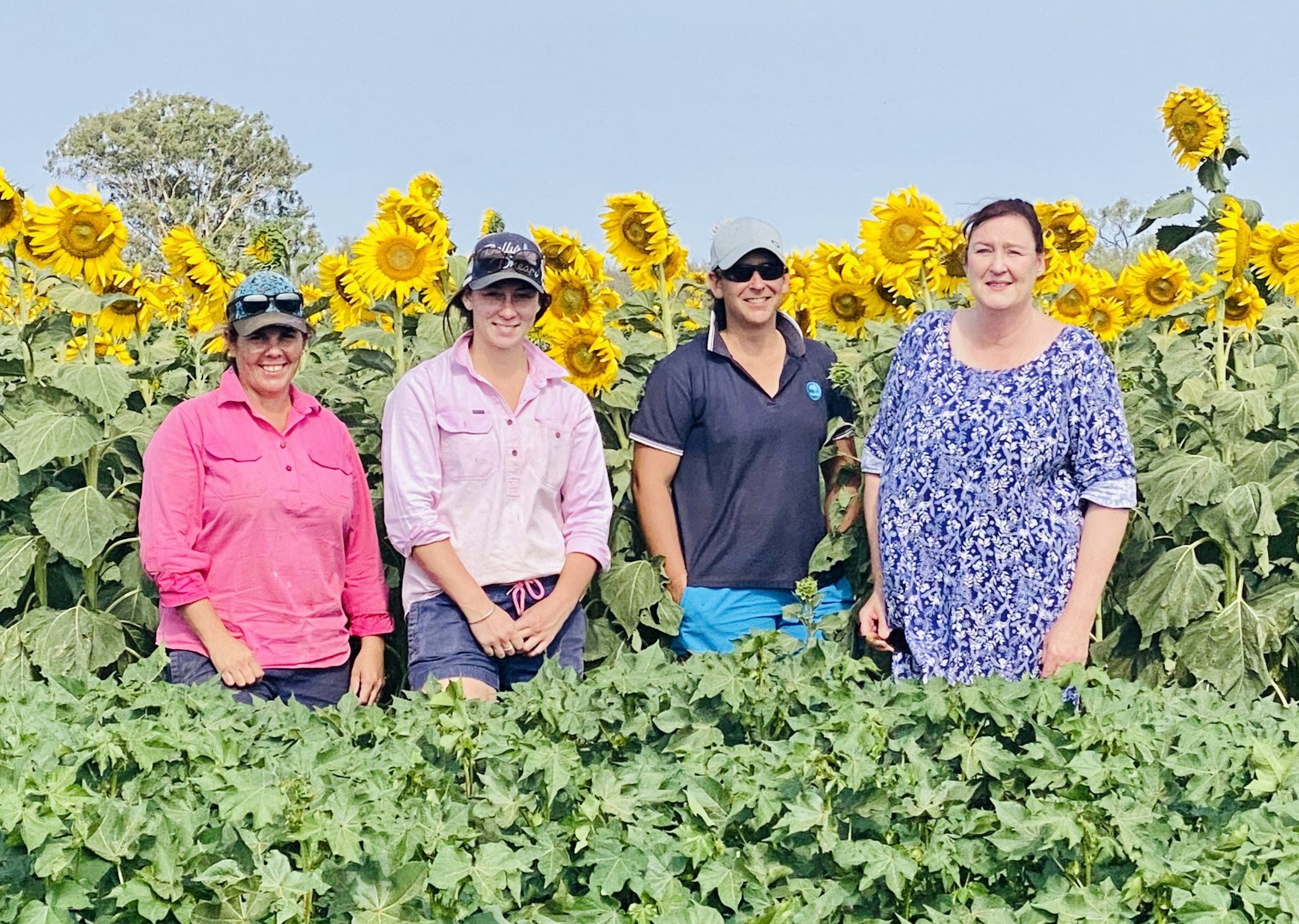By Simone Heimoana (PHD), Research scientist/CSIRO Cotton Research Unit/ Myall Vale
You may have noticed over the past few weeks that sunflowers are growing between rows of cotton opposite the Australian Cotton Research Institute (ACRI) along the Wee Waa Road. Apart from appreciating their bright yellow flowers in an otherwise drab landscape, you might have also wondered why they were there at all.
The sunflowers are part of CSIRO and CRDC’s ongoing research into integrated pest management (IPM) practices to improve how we deal responsibly with insect pests in cotton.
Cotton growers use a range of IPM tactics to manage pest and beneficial insect populations in their crops, with some cotton crops not sprayed for pests at all these days.
While every crop is host to pest insects such as caterpillars, aphids, mites and whiteflies, it also harbours beneficial insects that prey on these pests or parasitise them.
Spiders, lacewing and hoverfly larvae as well as a number of bugs and beetles are very efficient predators. Wasps too play their role, laying their eggs into caterpillars, aphids and whitefly nymphs so their larvae can feed and grow inside to emerge later as adults. Red and blue beetles, for example, are good generalist predators that eat moth eggs, larvae and slow-moving insects.
They also tolerate hot and dry conditions very well and survive on pollen when prey numbers are low.
Sometimes, however, pest numbers increase faster than predators can keep up with. In these situations, a grower may need to use an insecticide to manage the pest before it causes economic loss to the crop.
The ideal choice would be an insecticide that is very specific to killing the individual pest causing the problem, but which does not harm beneficial insects in the field.
In order to decide on the best chemical for the purpose, a grower relies on information that compares how various insecticides affect beneficial insects. Such information has been compiled by CSIRO researchers over the past 25 years from experiments conducted between the sunflowers.
Each year in early summer, potential new chemicals are tested at ACRI for their effects on beneficial insects and how well they fit with the IPM program.
Experiments are separated by strips of sunflower, which serve as physical dividers, reducing wind and spray drift between plots, and also acting as refuges and reservoirs for beneficial insects that can move around.
For five weeks, insects are subjected to a weekly spray. Their numbers are assessed twice a week by technical staff who identify and count around 350,000 insects under the microscope each season. Results are analysed and published in the annual Cotton Pest Management Guide.
A sound IPM program relies on accurate and regular monitoring of pests (bug checking) to avoid unnecessary spraying. Agronomists check each crop twice a week to keep track of any increase in pest populations and beneficial species numbers. There is a different sampling protocol for each type of pest and decisions are made based on a recommended pest threshold.
Knowing how much damage a plant can tolerate and compensate for without losses in yield or quality is important when setting pest thresholds.
To understand how insects interact with plants, researchers either infest experiments with large numbers of glasshouse-reared pests or artificially remove leaves and fruits from plants to determine the point of where plants begin to suffer.
In order to successfully infest a crop with a pest, beneficial insects need to be temporarily suppressed with an insecticide. Then, pieces of cut up cotton plants that are infested with mites or aphids are placed in the crop, and as these pieces dry up, the insects walk off into the crop.
However, for Silverleaf whitefly it is not that simple. Adult Silverleaf whitefly are fragile, highly mobile and easily killed or lost during transport to the field. Their nymphs, however, are not mobile and stay on the same spot on a plant until they turn into adults. For this reason, Silverleaf whitefly are reared on crinkly kale plants in the glasshouse. Pots of kale are then carefully moved to the field and are planted between cotton plants in the trial plots.
As the weather gets hotter, the kale, which is a winter crop, gradually dies off, allowing the Silverleaf whitefly nymphs to mature and get amongst the cotton.
As these infestations takeoff, researchers measure the increases in population and crop responses, such as reduced leaf area, flower and square loss, damage to cotton bolls and lint, and overall delay in maturity and reduction in yield.
Some pests, such as mirids, are much harder to rear in large numbers in a lab or glasshouse, so damage may be simulated by fully or partially removing squares and young bolls from different areas of cotton plants.
This is very labour-intensive as hundreds of plants need to be damaged, but it is worth the effort in terms of results.
Using all the data gathered from the trials, researchers are then able to determine how much pest damage cotton can tolerate, which becomes the basis for the recommended pest threshold.
Reliable monitoring criteria and a better understanding of the impact of pesticides on beneficial insects complement each other to provide sound and responsible decision support tools for the cotton industry.
IPM research aims to minimise disruption to the natural system by reducing chemical inputs wherever possible.
Comparing five-year averages from 1998 to 2003 and 2010-15, there was a 92 per cent reduction in insecticide use in the Australian cotton industry.
In most years, the system works quite well but it can be disrupted by adverse weather conditions, seasonal pest influxes, biosecurity threats or technology failure such as the build-up of resistance to particular pesticides by pests.
That is why it is important to have continuity in research, even in times of drought. Continuing research also maintains jobs for local staff and supports the Narrabri community.
Operating on a limited bore water supply, staff at ACRI are acutely aware of the severe drought situation and have kept their experimental acreage to an absolute minimum. To reduce the planted area, they have designed dual purpose experiments, where a trial can be used for one experiment early in the season and for another later in the season. To further save water, experiments that do not need to be carried through to a harvested yield are terminated by ploughing them in early.
To order photos from this page click here




